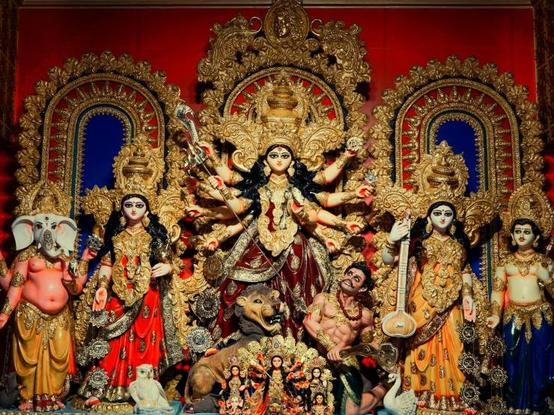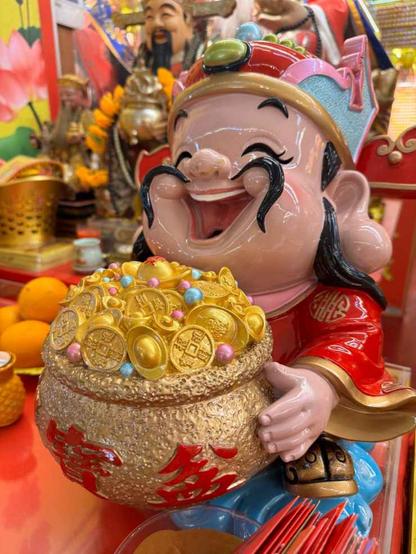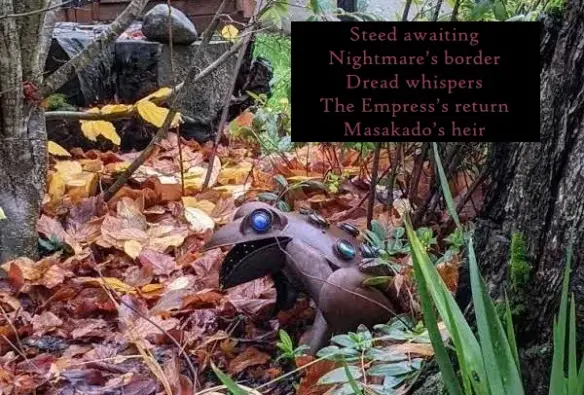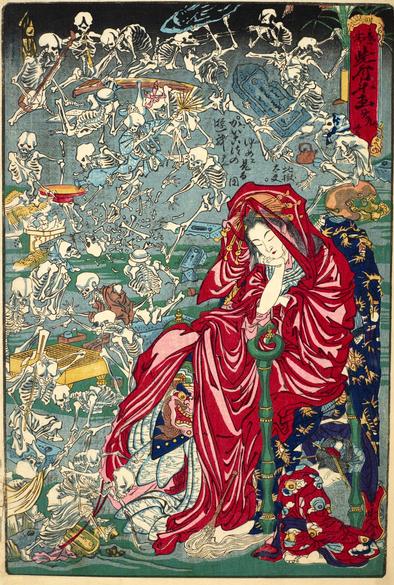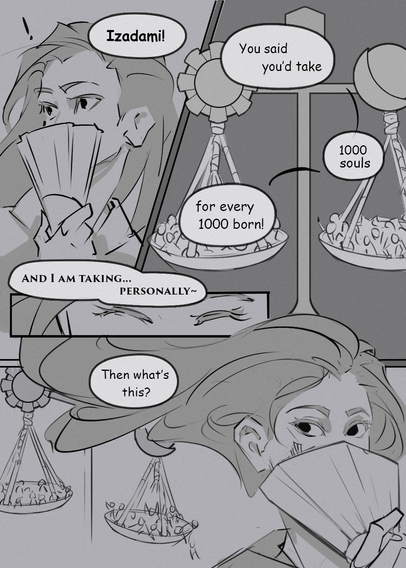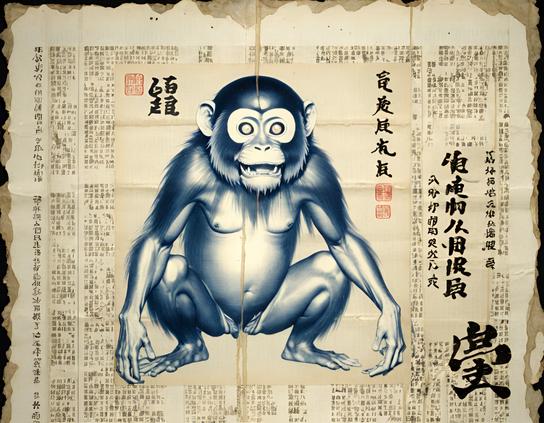#japaneseMythology
Tridevi
This is a trinity of supreme divinity in Hinduism. This joins a triad of well-known goddesses of the Trimurti, or as consorts of a masculine Trimurti. This depends on the denomination of Hinduism. This triad is typically personified by the Hindu goddesses Saraswati, Lakshmi, & Parvati. In Shaktism, these triune goddesses are the manifestations of Mula-Prakriti or Mahadevi. Triune means “3 in 1″ or 3 united in 1.”
In traditional masculine/male-centered (androcentric) denominations of Hinduism, the female Tridevi goddesses are relegated as consorts & auxiliary deities to the male/masculine Trimurti gods.
In Shaktism, the female/feminine Tridevi goddesses are given prominent roles of creator (Mahasaraswati), preserver (Mahalakshmi), & destroyer (Mahakali). In this sect, the male/masculine Trimurti God’s being put into auxiliary deities as agents of the female/feminine Tridevi.
Saraswati is the goddess of learning, acts, & music. She’s also the consort of Brahma, the creator.
Lakshmi is the goddess of fortune, wealth, fertility, auspiciousness, light, material & spiritual fulfillment. She’s the consort of Vishnu, the maintainer or preserver. Lakshmi doesn’t signify mere material wealth, but also abstract prosperity, such as glory, magnificence, joy, exaltation, greatness, & spiritual fulfillment. This translates to moksha. Moksha is liberation or release from the cycle of life, death, rebirth.
Parvati is the goddess of power, war, beauty, & love. She’s the consort of Shiva, the destroyer of evil, or transformer.
Mahasarasvati is described to be the slayer of Shumba in Devi Bhagavata Purana. This suggests that she has little to do with Saraswati.
Mahalakshmi is the prosperity aspect of Devi. She has 2 forms, Vishnu-priya Lakshmi & Rajyalakshmi. The former is the embodiment of chastity & virtuousness. The latter goes about courting kings.
Rajyalakshmi is stated to be fickle & impulsive. She enters all those places where virtue & charity may be found. As soon as these 2 vanish from any place, Rajyalakshmi will also vanish from that place.
Mahakali represents darkness, pure tamas personified. Mahakali is 1 of the 3 primary forms of Devi. She’s stated to be a powerful cosmic aspect (vyasti) of Devi & represents the guna (universal energy) named tamas, & is the personification of the universal power of transformation, the transcendent power of time.
Via Buddhism & syncretism with Japanese Shinto deities, the Tridevi entered Japanese mythology as the goddesses Benzaitennyo (Sarasvati), Kisshoutennyo (Lexmi), & Daikokutennyo (Mahakali or Parvati).
One-Time Monthly YearlyMake a one-time donation
Make a monthly donation
Make a yearly donation
Choose an amount
$1.00 $5.00 $10.00 $1.00 $5.00 $10.00 $5.00 $10.00 $15.00Or enter a custom amount
$Your contribution is appreciated.
Your contribution is appreciated.
Your contribution is appreciated.
DonateDonate monthlyDonate yearly
#Androcentric #Benzaitennyo #Brahma #Buddhism #Consorts #Daikokutennyo #Devi #DeviBhagavataPurana #Guna #Hindu #HinduMythology #HinduTridevi #Hinduism #HinduismPantheon #Japanese #JapaneseMythology #Kisshoutennyo #Lakshmi #Mahadevi #Mahakali #Mahalakshmi #Mahasarawati #MulaPrakriti #Parvati #Rajyalakshmi #Saraswati #Shaktism #Shinto #Shiva #Tamas #Tridevi #Trimurti #Trinity #Triune #Vishnu #VishnuPriyaLakshmi #Vyasti
Seven Lucky Gods
In Japanese mythology, the 7 Lucky Gods that are believed to grant good luck & are often represented in netsuke & in artwork. Netsuke is a miniature sculpture, beginning in 17th century Japan. 1 of the 7, Jurojin, is said to be based on an actual historical figure.
These deities mostly have their roots as ancient gods of fortune from religions popular in Japan like: from Mahayana Buddhism (Benzaiten, Bishamonten, Daikokuten, Hotei), which came to Japan via China but began in India; & from Chinese Taoism (Fukurokuju & Jurojin); the last 1 (Ebisu) is has a Japanese native ancestry.
In the beginning, these gods were worshipped by merchants as the first 2 (Ebisu & Daikokuten) were gods of business & trade. Other classes of Japanese society looked for gods that could parallel with their professions: Benzaiten as the patron of the arts, Fukurokuju as the patron of the sciences, etc.
In ancient times, these gods were worshipped separately. This rarely happens today. Only when it’s required for the specific god to act on behalf of the applicant.
The 7 Gods of Fortune started being mentioned as a collective in 1420 in Fushimi. This was in order to imitate the processions of the feudal lords, daimyos, of pre-modern Japan.
It’s said that Buddhist priest, Tenkai, picked these gods after speaking with the shogun he served, Iemitsu Tokugawa. This was at the order of seeking whoever possessed the perfect virtues: longevity, fortune, popularity, sincerity, kindness, dignity, & magnanimity. Shortly after this, Kano Yasunobu, a famous artist of the time.
List of the deities:
- Ebisu: From the era of the gods Izanami & Izanagi, Ebisu is the only 1 whose beginnings are purely Japanese. He’s the god of prosperity & wealth in business, & of plenitude & abundance in crops, cereals, & food in general. He’s the patron of fishermen & is shown with fishermen’s costumes such as a typical hat, a fishing rod in his right hand & a fish that is either a carp, a hake, a codfish, a sea bass, or any large fish. In general, that symbolizes abundance in meals, like a feast or banquet. It’s now common to see his figure in restaurants where fish is served in huge amounts of in household kitchens.
- Daikokuten: He’s the God of commerce & prosperity. He’s sometimes considered the patron of cooks, farmers, bankers, & a protector of crops. He’s also considered a demon hunter. Legend says that the god Daikokuten hung a talisman on the branch of a tree in his garden &, by using this as a trap, was able to catch a demon. This god is known for his smile, his short legs, & the hat on his head. He’s usually shown with a bag full of valuable objects. Daikokuten’s popular imagery started as a syncretic conflation of the Buddhist death deity, Mahakala, with the Shinto deity, Okuninushi. Syncretic conflation is a blending of different belief systems practices or traditions into a new, single, & often confusing or contradictory whole. The Japanese name Daikoku is a direct translation of the Sanskrit name Mahakala, which means “Great Blackness.” Per the Butsuzozui compendium of 1690, Daikoku can also manifest as a female known as Daikokunyo (literally, She of Great Blackness) or Daikokutennyo (literally, She of Great Blackness of the Heavens).
- Bishamonten: Bishamonten’s origins can be traced back to Hinduism. But he has been adopted into Japanese culture. He comes from the Hindu god Kubera & is also from the name Vaisravana. He’s the god of fortune in war & battles. He’s also connected with authority & dignity. He’s the protector of those who follow the rules & behave properly. As the patron of fighters, he was represented dressed in armor & a helmet. He’s often seen carrying a pagoda. He also acts the protector of holy sites & important places & wields a spear to fight against the evil spirits. He’s usually shown in pictures with a hoop of fire.
- Benzaiten: Benzaiten’s origin is found in Hinduism. As she comes from the Hindu goddess Saraswati. She’s the only Fukujin in modern grouping. She’s named in a number of ways: Benzaiten, Benten, Bentensama, or Benzaitennyo. When she was adapted from Buddhism, she was given the qualities of financial fortune, talent, beauty, & music among others. Often she shows up with a Torii. She’s depicted as a smart, beautiful woman with all the aforementioned attributes. She carries a biwa, a Japanese traditional lute-like instrument, & is normally accompanied by a white snake. She’s the patron of artists, writers, dances, & geisha.
- Jurojin: He’s considered the incarnation of the southern pole star, Jurojin, is the god of the elderly & of longevity in Japanese Buddhist mythology. It’s said that the legendary Juroujin is based on a real person who lived in ancient times. He was approximately 1.82 meters (or 5.97 feet) tall with a very long head. Besides his unique skull, he’s shown with a long white beard, riding a deer, & is often accompanied by a 1500-year crane (the bird) & a tortoise. These are symbols of his affinity with long lives. In addition, he is usually represented under a peach tree. The fruit of this tree is considered, by Chinese Taoism, being able to prolong life. In his hand, he holds a crane & a book or a scroll. The wisdom of the world remains written in its pages. Jurojin enjoys rice & wine &is a very cheerful figure.
- Hotei: He’s the god of fortune, guardian of children, patron of diviners, & barmen. He’s also the god of popularity. He’s shown as a fat, smiling, bald man with a curly moustache. He always appears half-naked. His clothes aren’t wide enough to cover his huge belly. He blessed the Chinese. They nicknamed him “Cho-Tei-Shi” or “Ho-Tei-Shi,” meaning ‘bag of old clothes.’ Hotei was a Zen priest. His looks & some of his actions were against their moral code. His looks made him look like a naughty person & he didn’t have a fixed place to sleep. He carries a bag on his shoulders. The bag was loaded with fortunes for those who believe in his virtues. Hotei’s traits & virtues are contentment, magnanimity, & happiness. Hotei’s original Chinese name was Kaishi. According to legend, he passed away in March 916. The Japanese began to believe in Hotei during the Edo era. The reasoning for why the Japanese have such a great respect for this god comes from a legend that says that, before Zen Buddhism came to Japan, an alternative Buddhist thought was extended by a priest of suspicious aesthetic, who was actually was a manifestation of Miroku. Miroku was the patron of those who couldn’t be saved by the beliefs of Buddha. Hotei was later observed & accepted by the Japanese as a 2nd Miroku.
- Fukurokuju: (Sometimes omitted) The god Fukurokuju also has his beginnings in China. It’s believed that he used to be a hermit during the Chinese Song dynasty. He’s distinguished for being a reincarnation of the Taoist god, Hsuan-wu. He’s the god of wisdom, luck, longevity, wealth, & happiness. This god receives certain credits, such as being 1 of the Chinese philosophers who could live without eating called breatharian. He’s the only god who was said to have the ability to resurrect the dead. Fukurokuju is portrayed by the size of his head, being almost as large as the size of his whole body. He’s represented wearing traditional Chinese costumes. He normally carries a cane in 1 hand & a scroll with writings about the world in the other hand. He’s usually accompanied by a turtle, a crow, or a deer. These animals are frequently used in Japan to symbolize a long life. It’s also said that he likes to play chess. He’s the patron of chess players. The characteristics of Fukurokuju & Jurojin overlap as they both trace back to the Chinese Taoist deity. Nanjilaoren, which is why Fukurokuju’s position is sometimes granted instead to the goddess Kichijoten, as in Butsuzosui compendium of 1783. The Butsuzosui compendium is a collection of Buddhist iconographic sketches said to have been painted by Hidenobu Tosa of the Tosa school. Originally published in 1690 in 5 volumes.
- Kichijoten: (Sometimes omitted) She’s also known as Kisshoten or Kisshoutennyo. She was adapted via Buddhism from the Hindu goddess Lakshmi. Kisshoten has the traits of beauty, happiness, & fertility. In the 1783 edition of the Butsuzozui compendium, Kichijoten replaced Fukurokuju as 1 of the Fukujin. Kichijoten’s iconography is distinguished from the other Fukujin goddesses by the Nyoihiju gem in her hand. When Kichijoten replaces Fukurokuju, & Daikoku is regarded in feminine form, all 3 of the Hindu Tridevi goddesses are then represented among the 7 Fukujin.
During the first 3 days of the New Year, the 7 Lucky Gods are said to pilot through the Heavens the Takarabune or Treasure Ship. A picture of the ship forms an essential part of traditional Japanese New Year celebrations.
There are 4 shrines:
- Imamiya Ebisu Shrine, Osaka
- Nanyo Kanjizai, Shikoku
- Nishinomiya Shrine, Hyogo
- Toka Ebisu Shrine, Fukuoka
Make a one-time donation
Make a monthly donation
Make a yearly donation
Choose an amount
$1.00 $5.00 $10.00 $1.00 $5.00 $10.00 $5.00 $10.00 $15.00Or enter a custom amount
$Your contribution is appreciated.
Your contribution is appreciated.
Your contribution is appreciated.
DonateDonate monthlyDonate yearly
#1420 #1690 #1783 #17thCentury #Benten #Bentensama #Benzaiten #Benzaitennyo #Bishamonten #Biwa #Breatharian #Buddha #Buddhism #ButsuzosuiCompendium #China #ChineseTaoism #ChoTeiShi #Daikoku #Daikokunyo #Daikokuten #Daikokutennyo #Daimyos #Ebisu #EdoEra #Fukujin #Fukuoka #Fukurokuju #Fushimi #HidenobuTosa #HinduTridevi #Hinduism #HinduismPantheon #HoTeiShi #Hotei #HsuanWu #Hyogo #IemitsuTokugawa #ImamiyaEbisuShrine #India #Izanagi #Izanzmi #Japan #JapaneseBuddhistMythology #JapaneseMythology #Jurojin #Kaishi #KanoYasunobu #Kichijoten #Kisshoten #Kisshoutennyo #Kubera #Lakshmi #Mahakala #MahayanaBuddhism #March916 #Miroku #Nanjilaoren #NanyoKanjizai #Netsuke #NewYear #NishinomiyaShrine #NyoihojuGem #Okuninushi #Osaka #Pagoda #Patron #PeachTree #Reincarnation #Sanskrit #Saraswati #SecondMiroku #SevenLuckyGods #Shikoku #Shinto #SongDynasty #SouthernPoleStar #SyncreticConflation #Takarabune #Tenkai #TokaEbisuShrine #Torii #TosaSchool #TreasureShip #Vaisravana #ZenBuddhism #ZenPriest
✨ Discover the eternal light of Amaterasu-Ōmikami, the Sun Goddess of Shinto. From celestial threads of sunlight to the sacred mirror that reflects divine power, her story illuminates life itself. 🌅🪞
Read more on my blog: https://aoiwave.wordpress.com/2025/09/22/amaterasu-omikami-the-eternal-dance-of-divine-light/
#Amaterasu #Shinto #DivineLight #JapaneseMythology #Spirituality #AnimeInspired #EternalLight
Pom Poko 2 - in which the tanuki leave Japan to cause mischief in America.
Caught this one near the Wellington Brown Line stop in Chicago.
#Chicago #Ghibli #StudioGhibli #TakahataIsao #JapaneseMythology #Folklore #Movies #JapaneseFolklore #Mytholology #MythicalCreatures #Tanuki #Restaurant
#WordWeavers 10. You have to leave Earth, and you can only immigrate to one of the settings you’ve written. Where do you go?
Tokyo, but that on earth. There are only a few nice places I describe in Kakuriyo, but the Mayoiga is a good place. A manor that takes care of all your needs. Peace, quiet, serenity. The drawback is that after you die, you need someone to perform the last rites for you. Until then, you're stuck as a ghost.
#PennedPossibilities 667. At the moment, what is your MC’s highest priority?
As where we are published, Finding the Kudan's Mate. A mythical figure said to be the only creature that can nullify a prophecy by the Kudan, the sole loophole in the saying "The Kudan never lies."
In the overall picture, it is to banish or other nutrilize Mikawa-san, a powerful onryo or vengeful ghost.
I painted a Japanese yōkai called 予言の鳥 (Yogen no tori). medium: Nicker poster colour on Arches watercolour paper #Yokai #JapaneseFolklore #JapaneseMythology #Art #Illustration
滝夜叉姫を待つ
Waiting for Princess Takiyasha
Steed awaiting
Nightmare’s border
Dread whispers
The Empress’s return
Masakado’s heir
Copyright Nara Moore ©️ Do not use in AI
📷#Photography #マストドン写真部 #写真
🏙️#urbanphotography #都市写真
#Waka #和歌 #WakaPoetry #Haiga #俳画
#haiku #poetry #詩 #poetrycommunity
@poetry
🐸#Frog #かえる #FrogFriday
#Yokai #youkai #妖怪
#滝夜叉姫 #Folklore #伝説 #japaneseMythology
« Jigoku dayu » (Hell Courtesan), 1874
by Kawanabe Kyōsai (Japanese master, 1831-1889)
color woodcut, 35x24 cm
#vintagefantasyart #fantasyart #fantasyillustration #KawanabeKyosai #yokai #yorei #japanesemythology
Don’t miss out on grabbing some cashback on souls from Izanami while the deal’s still on! 💸🖤
Japanese mythology’s got creation gods Izanami & Izanagi. She swore to take 1000 souls a day, but he said he’d bring 1500 babies to life. In our game, we’re all about balance—life & death gotta stay even. But something’s gonna mess it up… Who do you think?
#indiedev #indiegame #gamedev #selfdevour #metroidvania #art #JapaneseCulture #actionadventure #darkfantasy #Japanesemythology #Rugamedev
When’s the last time you checked those dusty rags shoved in the corner? If it’s been a while, watch out — Ittan-momen might be lurking! 🪭
In Japanese folklore, forgotten stuff can turn into yokai-tsukumogami — basically, things that come to life. Ittan-momen — a sneaky flying cloth that loves ambushing distracted travelers and wrapping around their necks. In our game, it’s just as fast and tricky! 😈
#indiedev #indiegame #gamedev #selfdevour #metroidvania #art #Japanesemythology
Our new animator Konstantin finished making a rough draft for one of the enemies' movements. It looks awesome!
#indiedev #indiegame #gamedev #selfdevour #metroidvania #art #JapaneseCulture #actionadventure #darkfantasy #Japanesemythology #Rugamedev
For Love of a Konbini Idol, I Searched for the Kudan
Chapter 51 Released
House of Longing (憧れの家)
By Nara Moore
Art Mai-sensei
Tomo, Kan-chan, Ume, and Shishi are reunited in the House of Longing. Will temptation outweigh reality?
Join Ume & her family as their relationships develop. In a creepy world where “love” never dies
---------
At: https://www.pixiv.net/novel/series/11417104
https://archiveofourown.org/works/52770025
Artist: https://bsky.app/profile/maisart.bsky.social
Tags: #KonbiniIdol #LGBTQ #LightNovel #ParanormalRomance #QueerFiction #Romance #Sapphic #SapphicRomance #Yuri #Queer #japaneseMythology #mythology
#ai #aiArt #aiArtWork #VintageArt #JapaneseFolklore #MonsterIllustration #RiverBoy #KappaMonster #ScaryCreatures #MythologyArt #BlackInkArt #BeigeBackground #DetailedDrawing #IllustrationArt #HighResolution #TraditionalArt #FolkloreCreatures #ai #aiArt #aiArtWork #vintage #newspaper #illustration #ScaryMonster #JapaneseMythology #riverboy #ferocious #monkeyface #gills #fins #scaly #webbed #creature #emotions #blackink #beigepaper #highresolution #detailed #diagram #ChineseText
Three days into crafting our game's lore, aiming for that Hollow Knight vibe. Only 1/4 done, but the real challenge? Telling this epic tale with barely any text, through visuals and scattered phrases. PressF to my sleep schedule 😱😎 #LoreBuilding #HollowKnight #indiedev #gamedev #metroidvania #2dgame #platformer #gameart #indiegame #gaming #videogames #japanesemythology #darkfantasy #actionadventure #gamedevelopment
A kappa is a Japanese mythological water sprite or, literally, "river child" (河童). One of the more popularly known yōkai (Japanese mythological creature) in Japan, kappa are generally green or yellow, have a tortoise-like shell on their backs, a tonsured head, and a fishy smell. #History #Kappa #JapaneseMythology #HistoryFact https://whe.to/ci/1-23933-en/
For today's #YearOfTheSnake thread, we focus on #snake -themed #poetry, like this aptly named collection by Lee Ann Roripaugh that deals with ideas of transformation, mixed-race female identity & #JapaneseMythology
https://opac.sub.uni-goettingen.de/DB=1/XMLPRS=N/PPN?PPN=370804945
Prepare for legendary tales and epic battles! The Ghost of Tsushima: Legends Anime, blending samurai action with mythic storytelling, is coming to Crunchyroll in 2027. Directed by Takanobu Mizuno and penned by Gen Urobuchi, this is one adaptation you won't want to miss!
Read the full article right here: https://www.theomenmedia.com/post/samurai-legends-come-to-life-ghost-of-tsushima-legends-anime-confirmed-for-2027
#GhostOfTsushimaAnime #LegendsAnime #Crunchyroll2027 #SonyAnime #SamuraiAnime #JapaneseMythology #AnimeNews #GamingToAnime #MizunoTakanobu #UrobuchiGen

